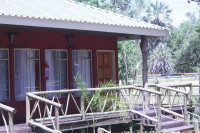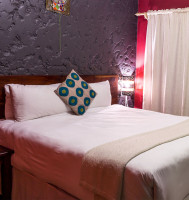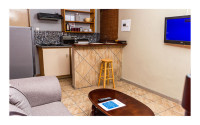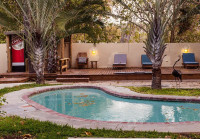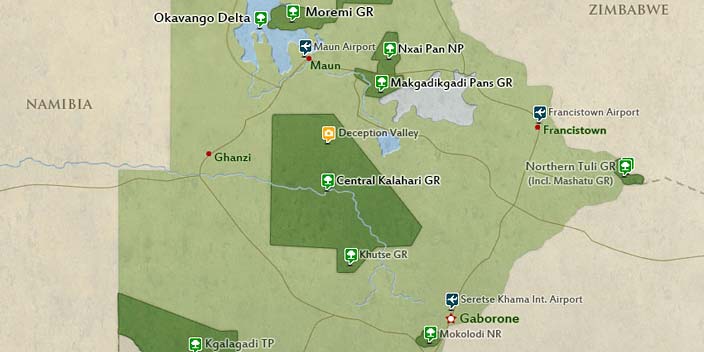
$3,249 pp (USD)
2 travelers on Start dateArrival
Arrival

Day 1
Arrive in Maun, Zazu team will pick you from Maun airport and transfer you to Rivernest cottages
Arrive in Maun, Zazu team will pick you from Maun airport and transfer you to Rivernest cottages
Maun was founded in 1915 as the tribal capital of the Batawana people, and has had a reputation as a hard-living 'Wild West' town which was the economic center of local cattle ranching and hunting operations. However, with the growth of the tourism industry and the completion of the tar road from Nata in the early 1990s, Maun has developed swiftly, losing much of its old town character. It is now home to over 55,000 people.
Maun is today a thriving tourist town, infamous for its infestation of donkeys and to a lesser extent goats. These animals can be seen standing around town as the local farmers arrive in the innumerable taxis to sell their wares on the curbside.
The name Maun is derived from the Seyei word 'maung', which translates 'the place of river reeds'. Before the arrival of Batawana, Maun was a small Yei village. The village in 1915 became the capital for the Batawana people. The capital was transferred from Toteng after victory over Ndebele King Lobengula.
- Main Destination:
- Maun (City)
- Accommodation:
- Rivernest Cottages
- Meals & Drinks:

Day 2-4
Moremi game reserve
Moremi game reserve
The Moremi Game Reserve initially consisted mostly of the Mopane Tongue area, but in the 1970s the royal hunting grounds, known as Chief’s Island, were added. Let us share a few more facts about this area to introduce it properly. The Moremi is home to the most endangered species of large mammals: the cheetah, African wild dog and lion. Over 500 bird species (from water birds to forest dwellers) and over a 1.000 species of plants are also recognized in the Moremi. This ecosystem is amongst the richest in Africa. And thanks to effective protection, the flora and fauna is relatively undisturbed.
Within the Okavango Delta Moremi Game Reserve, covers about 40% of the Okavango. The Moremi and the Okavango Delta is one of the few interior delta systems that do not directly flow into the ocean or sea. The annual flood makes for a spectacular interaction between water and wildlife, as animals synchronize their cycles with this seasonal flood.
Lifeline.
- Main Destination:
- Moremi Game Reserve (Okavango Delta)
- Accommodation:
- Mid-range camping
- Meals & Drinks:

Day 5-6
Khwai Concession
Khwai Concession
The Khwai Community Concession was created by the people of the Khwai village, a small settlement on the eastern edge of the Okavango Delta. Khwai village borders the Moremi Game Reserve and is home to a population of around 400 people, majority of them Babukakhwe, a descendant from the San Bushmen.
The Khwai Development Trust manages the Khwai Community Concession, focusing on sustainable eco-tourism and conservation. Khwai village and the surrounding villages such as Mababe show just how local communities live in harmony with the wildlife in the area.
Wildlife is abundant in Khwai, even within the village. You are very likely to see a pride of lions lazing in the road on your morning game drive or hippos wallowing in the river, the elephants are a constant in Khwai and there is a healthy population of African Wild Dogs in the area. As well as all the plains game it is very probable that you will catch glimpse of some of Africa’s Big 5. With a plethora of birdlife in the area.
- Main Destination:
- Khwai Concession (Okavango Delta)
- Accommodation:
- Mid-range camping
- Meals & Drinks:

Day 7
Travel back to Maun; end of safari
Travel back to Maun; end of safari
Maun was founded in 1915 as the tribal capital of the Batawana tribe, and has had a reputation as a hard-living 'Wild West' town which was the economic center of local cattle ranching and hunting operations. However, with the growth of the tourism industry and the completion of the tar road from Nata in the early 1990s, Maun has developed swiftly, losing much of its old town character. It is now home to over 55,000 people.
Maun is today a thriving tourist town, infamous for its infestation of donkeys and to a lesser extent goats. These animals can be seen standing around town as the local farmers arrive in the innumerable taxis to sell their wares on the curbside.
The name Maun is derived from the Seyei word 'maung', which translates 'the place of river reeds'. Before the arrival of Batawana, Maun was a small Yei village. The village in 1915 became the capital for the Batawana people. The capital was transferred from Toteng after victory over Ndebele King Lobengula.
- Main Destination:
- Maun (City)
- Accommodation:
- No accommodation (End of tour)
- Meals & Drinks:


